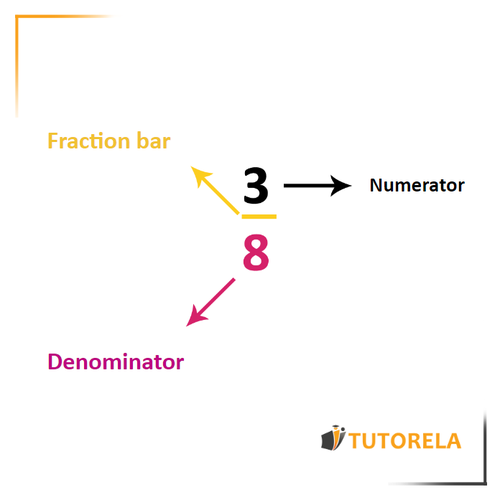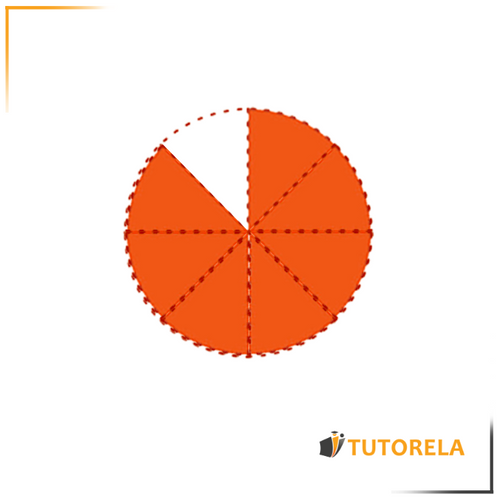The denominator is the bottom number of a fraction and represents the whole in its entirety.
For example:

The denominator is the bottom number of a fraction and represents the whole in its entirety.
For example:

Write the fraction shown in the picture, in words:
In this article, you will learn everything you need to know about the denominator and its function in fractions.
The denominator is one of the components of a fraction, therefore, to better understand what the denominator is, let's first talk about fractions.
A fraction is a number that is composed of two numbers:
The upper one which is called the numerator
A fractional line that represents a division
And the lower number which we call the denominator
For example:

The fraction could represent a certain part or even the entirety of a whole.
Write the fraction shown in the picture, in words:
Write the fraction shown in the picture, in words:
Write the fraction shown in the picture, in words:
The denominator represents the whole itself, that is, the totality of parts or portions there are.
For example, in the fraction
,
The denominator indicates that is the whole, in total there are parts.
Explanatory note as a gift: The in the numerator represents a certain part within the whole parts within , that is, eighths.
Let's see it illustrated:

Discover the fractions whose denominator is :
Solution:
In this fraction, the denominator is –> the number located at the bottom.
In this fraction, the denominator is –> the number located at the bottom.
Write the fraction shown in the picture, in words:
Write the fraction shown in the picture, in words:
Choose the answer that describes in words the fraction shaded in pink:
Write fractions whose denominator is :
Solution:
In the three fractions we wrote, the denominator is . Any fraction you write that has the number as the denominator and any whole number as the numerator will be a correct answer.
Write the fraction shown in the picture, in words:
To solve this problem, we'll write the fraction shown in the picture in words. The steps to solve this are straightforward:
Count the number of total equal parts in the grid. In the picture, the grid consists of 9 equal parts.
Identify the number of shaded parts. There are 6 shaded parts in total.
Write the fraction using the total parts and shaded parts. The fraction is .
Express the fraction in words. In words, is "six ninths."
Therefore, the written fraction from the picture in words is "Six ninths".
Six ninths
Write the fraction shown in the picture, in words:
To solve the problem of expressing the fraction in words, follow these steps:
Now, let's work through these steps:
Step 1: The grid consists of a layout, which means there are 9 total sections. Therefore, the denominator of our fraction is 9.
Step 2: Observe and count the number of shaded sections within the grid. In this case, there are 4 shaded sections. Therefore, the numerator is 4.
Step 3: With a fraction identified as , we can express this in words as "four ninths."
Therefore, the solution to the problem is four ninths.
Four ninths
Write the fraction shown in the picture, in words:
To solve this problem, we need to translate the visual fraction representation into words:
Thus, the fraction shown in the picture, in words, is three ninths.
Three ninths
Write the fraction shown in the picture, in words:
Step 1: Count the total sections
The circle is divided into 8 equal sections.
Step 2: Count the shaded sections
There are 6 shaded sections in the diagram.
Step 3: Formulate the fraction
The fraction of the shaded area is .
Step 4: Express in words
The fraction in words is "six eighths".
Therefore, the solution to the problem is "six eighths".
Six eighths
Write the fraction shown in the picture, in words:
To solve this problem, we need to follow these steps:
Steps in detail:
Step 1: The diagram shows a circle divided into eight equal parts. This step lets us determine the denominator, which is eight.
Step 2: The circle has four parts marked as shaded. This provides the numerator of the fraction, which is four.
Step 3: Therefore, the fraction can be written by combining these numbers. The numerator (shaded parts) is four, and the denominator (total sections) is eight.
Step 4: In words, we express the fraction as "four eighths." This corresponds with option 3 in the choices given.
In conclusion, the fraction in the picture represented in words is four eighths.
Four eighths
Write the fraction shown in the picture, in words:
Write the fraction shown in the picture, in words:
Write the fraction shown in the picture, in words: